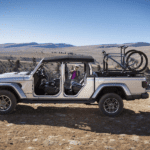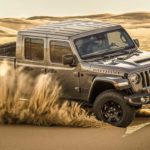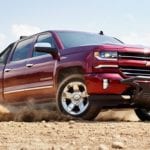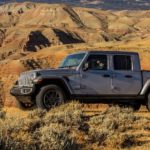Any visit to your local Jeep Gladiator dealer will introduce you to the latest workhorse from Jeep, a truck that blends practicality and function with a penchant for adventure. This trifecta characterizes the modern Gladiator and its recent return to the Jeep lineup in 2020, but it also begs the question of Jeep’s history in the truck segment. Today, the Gladiator is often likened to a Wrangler with a truck bed, but is this comparison accurate, and has this always been the case for the adventurous road warrior? Believe it or not, the Gladiator might be the best-known truck in Jeep history, but it’s not the only pickup to bear the legendary emblem.
The 1940s: Willys-Overland Truck
As history goes, Jeep was born out of necessity when the American military requested a light reconnaissance vehicle to aid in World War II. Despite the widespread request, only a handful of automakers responded with a design, ultimately leading to the Willys Quad dramatically impacting America’s efforts in the war in the early 1940s. This impact was so significant that Jeep introduced a civilian version, the Jeep CJ-2A, in 1945, immediately garnering widespread acclaim for its four-wheel drive capability.
The Jeep CJ paved the way for the Willys Wagon in 1946 and a more practical workhorse known as the Willys-Overland Truck in 1947. The two-wheel or four-wheel drive pickup shared the bare-bones design of the CJ but offered more capability as a one-ton model with a 118-inch wheelbase and a 62-horsepower four-cylinder engine. As a result, Jeep marketed it as a versatile workhorse for farm and industry, advertising that every feature was “engineered to contribute to efficient operations, long life, and pared-down expenses.” At a time when everyone was pinching pennies, the campaign and the no-name truck struck a chord.
Symbolically, the Willys-Overland Truck accomplished two remarkable feats. First, it was the first truck equipped with a four-wheel drive system, with Ford and Chevrolet offering this capability over a decade later in the late 1950s. Second, the truck’s success, despite its generic name, gave the automaker more reason to continue on a similar trajectory of diversifying its lineup to answer the vast needs of drivers. Ultimately, the Willys-Overland Truck set the stage for models like the Jeepster, Wagoneer, Gladiator, Grand Wagoneer, Cherokee, Grand Cherokee, and beyond.
The 1950s: FC-150 and FC-170
One of the boldest moves in Jeep history came in 1957 when the automaker introduced the FC-150 or cab-forward truck built on the CJ-5 chassis. The cab-forward truck looked nothing like the traditional Jeep lineup, distinguishing itself with its hoodless cab and flat nose design that enhanced visibility and maneuverability. Jeep used the truck’s unique aesthetic as a marketing tool, promoting the FC-150 with ads that read, “More cargo space! On less wheelbase! And goes anyplace!”
Fortunately, the FC-150 lived up to the marketing campaign and became a favorite among industrial workers and farmers. Its 18-foot turning radius allowed it to navigate even the tightest places with ease, while its capable powertrain and heavy-duty design guaranteed it could haul any load. Jeep capitalized on this capability, offering the FC-150 as a traditional pickup, chassis and cab, stake bed, and even a railway track inspection vehicle.
The FC-150’s popularity inspired Jeep to debut a larger and more capable alternative, the FC-170. Sharing the same chassis as the CJ-5, the FC-170 was longer than the FC-150, sitting on a 103.5-inch wheelbase compared to the FC-150’s 81-inch wheelbase. As expected, the bigger platform required a more capable six-cylinder engine and several updates to its overall performance and handling, including the option to add dual rear wheels for enhanced towing capability.
The 1960s: J-Series
By the early 1960s, sales of the Willys-Overland Truck were at an all-time low, leading Jeep to design a more modern alternative. Using the same platform as the Wagoneer, Jeep debuted the full-size J-Series in 1963. Initially known as the Gladiator, the full-size truck was available as a J-200 with a 120-inch wheelbase or a J-300 with a 126-inch wheelbase. This level of customization made the early Gladiator an instant success, with features like its high-strength independent front suspension and Dana 20 transfer case adding to its capability and appeal.
Jeep continued this trend, allowing drivers to choose several unique configurations to design the perfect J-Series for their needs. These options ranged from the narrow box Thriftside and the wide box Townside to the stake bed, wrecker, and chassis-mounted camper on an extended wheelbase. Jeep also offered its first V8 engine in 1965, later swapping the standard 140-horsepower engine with a 110-horsepower powerplant in 1971. The swap also rebranded the J-200 and J-300 as the J-2000 and J-3000, respectively, and marked the end of the Gladiator name, at least for the time being.
The name change introduced new models to the lineup, including the J-10 and J-20. Built on the same platform as the Wagoneer and Cherokee, the J-10 and J-20 featured heavier frame cross members, new front axles, front disc brakes, and several new trim options. In addition, their traditional step-side or slab-sided bodies gave drivers more options for customization. Jeep even introduced packages like the 10-4, which added a factory-installed CB radio to the truck.
The 1980s: CJ-8 Scrambler and Comanche
The J-Series met its demise in the 1980s, just as Jeep introduced the CJ-8 Scrambler in 1981 and the compact Comanche in 1986. The CJ-8 Scrambler made a lasting impression among drivers as a CJ with a five-foot pickup bed and a hard or soft roof. Sound familiar?
Unlike the trucks of years past, the Scrambler’s rear bed was little more than a cargo bay and wasn’t designed for hauling heavy equipment or bulkier items. Instead, it was a topless extension of the cab, which seems impractical by today’s standards. Even so, Jeep fans embraced the model until the automaker introduced the Comanche in 1986 and the Wrangler in 1987. While the Wrangler needs little introduction, the Comanche deserves a place in the spotlight as a four-wheel drive compact truck that distinguished itself with its uniframe design.
The Comanche shared many similarities with the XJ Cherokee, which added to its agility and capability when powered by the available 2.1L Renault diesel engine. However, it wasn’t enough to give the Comanche a strong foothold in the lineup. As a result, Jeep discontinued the truck in 1992, closing the chapter of the family of trucks that began in 1947.
The 2020s: Gladiator
Although Jeep discontinued its truck lineup in the early 1990s, die-hard Jeep fans still managed to outfit their Wranglers as trucks with aftermarket kits and modifications. However, there was still a gap in the lineup that no Wrangler Rubicon or Grand Cherokee could fill. Jeep recognized as much and, after years of speculation, finally reintroduced the Gladiator in 2020. While many anticipated the Gladiator to return as a modern version of the Scrambler, Jeep took a different approach and designed the Gladiator from the ground up to compete with mid-size rivals like the Ford Ranger, Chevrolet Colorado, and GMC Canyon.
The Gladiator celebrated its grand return with dizzying ground clearance, impressive towing ability, and off-road capability that sealed its fate in the Jeep fleet. In addition, it introduced a new genre of cutting-edge technology with its forward-facing TrailCam Off-Road Camera. It also made history as Jeep’s first Trail Rated truck, proving its prowess at handling the most extreme conditions off the pavement. But, as we see from Jeep’s past, the automaker refused to stop there.
Work Meets Adventure
Today, the Gladiator embodies Jeep’s long history in the American automotive industry, specifically the truck segment. It traces its roots to the Willys-Overland Truck of the late 1940s, which marked the first time Jeep diversified its lineup and thought outside the box of its military-style lineup. The bare-bones truck gave Jeep the confidence to expand into a segment that was foreign to them at the time and introduce drivers to a four-wheel drive pickup truck that was not only capable but practical and incredibly versatile.
The Gladiator continues that tradition, paying homage to its past and looking to the future with revolutionary models like the Gladiator Mojave that promise more capability than ever imagined. This progression characterizes the entire Jeep lineup, showcasing the automaker’s ability to encourage drivers to constantly explore uncharted territory and seek adventure anytime they’re behind the wheel. Trucks like the Gladiator and every model that came before it make answering the call of the wild easier, more practical, and far more enjoyable than anyone ever dreamed.




